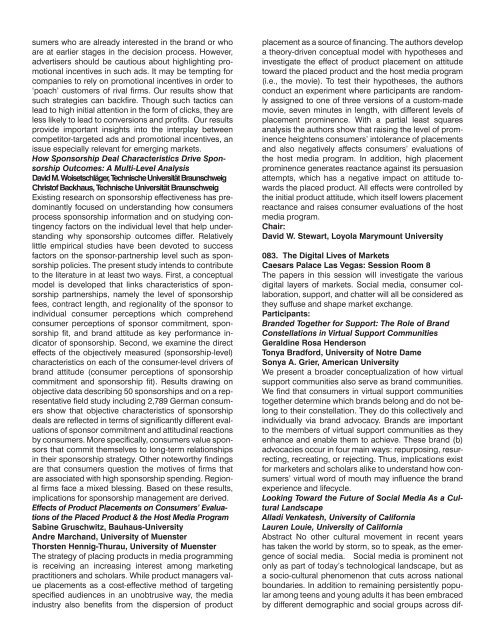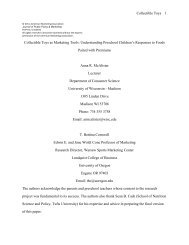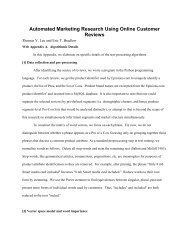Program 2013 Winter Marketing Educators' Conference Challenging ...
Program 2013 Winter Marketing Educators' Conference Challenging ...
Program 2013 Winter Marketing Educators' Conference Challenging ...
Create successful ePaper yourself
Turn your PDF publications into a flip-book with our unique Google optimized e-Paper software.
sumers who are already interested in the brand or who<br />
are at earlier stages in the decision process. However,<br />
advertisers should be cautious about highlighting promotional<br />
incentives in such ads. It may be tempting for<br />
companies to rely on promotional incentives in order to<br />
‘poach’ customers of rival firms. Our results show that<br />
such strategies can backfire. Though such tactics can<br />
lead to high initial attention in the form of clicks, they are<br />
less likely to lead to conversions and profits. Our results<br />
provide important insights into the interplay between<br />
competitor-targeted ads and promotional incentives, an<br />
issue especially relevant for emerging markets.<br />
How Sponsorship Deal Characteristics Drive Sponsorship<br />
Outcomes: A Multi-Level Analysis<br />
David M. Woisetschläger, Technische Universität Braunschweig<br />
Christof Backhaus, Technische Universität Braunschweig<br />
Existing research on sponsorship effectiveness has predominantly<br />
focused on understanding how consumers<br />
process sponsorship information and on studying contingency<br />
factors on the individual level that help understanding<br />
why sponsorship outcomes differ. Relatively<br />
little empirical studies have been devoted to success<br />
factors on the sponsor-partnership level such as sponsorship<br />
policies. The present study intends to contribute<br />
to the literature in at least two ways. First, a conceptual<br />
model is developed that links characteristics of sponsorship<br />
partnerships, namely the level of sponsorship<br />
fees, contract length, and regionality of the sponsor to<br />
individual consumer perceptions which comprehend<br />
consumer perceptions of sponsor commitment, sponsorship<br />
fit, and brand attitude as key performance indicator<br />
of sponsorship. Second, we examine the direct<br />
effects of the objectively measured (sponsorship-level)<br />
characteristics on each of the consumer-level drivers of<br />
brand attitude (consumer perceptions of sponsorship<br />
commitment and sponsorship fit). Results drawing on<br />
objective data describing 50 sponsorships and on a representative<br />
field study including 2,789 German consumers<br />
show that objective characteristics of sponsorship<br />
deals are reflected in terms of significantly different evaluations<br />
of sponsor commitment and attitudinal reactions<br />
by consumers. More specifically, consumers value sponsors<br />
that commit themselves to long-term relationships<br />
in their sponsorship strategy. Other noteworthy findings<br />
are that consumers question the motives of firms that<br />
are associated with high sponsorship spending. Regional<br />
firms face a mixed blessing. Based on these results,<br />
implications for sponsorship management are derived.<br />
Effects of Product Placements on Consumers’ Evaluations<br />
of the Placed Product & the Host Media <strong>Program</strong><br />
Sabine Gruschwitz, Bauhaus-University<br />
Andre Marchand, University of Muenster<br />
Thorsten Hennig-Thurau, University of Muenster<br />
The strategy of placing products in media programming<br />
is receiving an increasing interest among marketing<br />
practitioners and scholars. While product managers value<br />
placements as a cost-effective method of targeting<br />
specified audiences in an unobtrusive way, the media<br />
industry also benefits from the dispersion of product<br />
placement as a source of financing. The authors develop<br />
a theory-driven conceptual model with hypotheses and<br />
investigate the effect of product placement on attitude<br />
toward the placed product and the host media program<br />
(i.e., the movie). To test their hypotheses, the authors<br />
conduct an experiment where participants are randomly<br />
assigned to one of three versions of a custom-made<br />
movie, seven minutes in length, with different levels of<br />
placement prominence. With a partial least squares<br />
analysis the authors show that raising the level of prominence<br />
heightens consumers’ intolerance of placements<br />
and also negatively affects consumers’ evaluations of<br />
the host media program. In addition, high placement<br />
prominence generates reactance against its persuasion<br />
attempts, which has a negative impact on attitude towards<br />
the placed product. All effects were controlled by<br />
the initial product attitude, which itself lowers placement<br />
reactance and raises consumer evaluations of the host<br />
media program.<br />
Chair:<br />
David W. Stewart, Loyola Marymount University<br />
083. The Digital Lives of Markets<br />
Caesars Palace Las Vegas: Session Room 8<br />
The papers in this session will investigate the various<br />
digital layers of markets. Social media, consumer collaboration,<br />
support, and chatter will all be considered as<br />
they suffuse and shape market exchange.<br />
Participants:<br />
Branded Together for Support: The Role of Brand<br />
Constellations in Virtual Support Communities<br />
Geraldine Rosa Henderson<br />
Tonya Bradford, University of Notre Dame<br />
Sonya A. Grier, American University<br />
We present a broader conceptualization of how virtual<br />
support communities also serve as brand communities.<br />
We find that consumers in virtual support communities<br />
together determine which brands belong and do not belong<br />
to their constellation. They do this collectively and<br />
individually via brand advocacy. Brands are important<br />
to the members of virtual support communities as they<br />
enhance and enable them to achieve. These brand (b)<br />
advocacies occur in four main ways: repurposing, resurrecting,<br />
recreating, or rejecting. Thus, implications exist<br />
for marketers and scholars alike to understand how consumers’<br />
virtual word of mouth may influence the brand<br />
experience and lifecycle.<br />
Looking Toward the Future of Social Media As a Cultural<br />
Landscape<br />
Alladi Venkatesh, University of California<br />
Lauren Louie, University of California<br />
Abstract No other cultural movement in recent years<br />
has taken the world by storm, so to speak, as the emergence<br />
of social media. Social media is prominent not<br />
only as part of today’s technological landscape, but as<br />
a socio-cultural phenomenon that cuts across national<br />
boundaries. In addition to remaining persistently popular<br />
among teens and young adults it has been embraced<br />
by different demographic and social groups across dif-

















